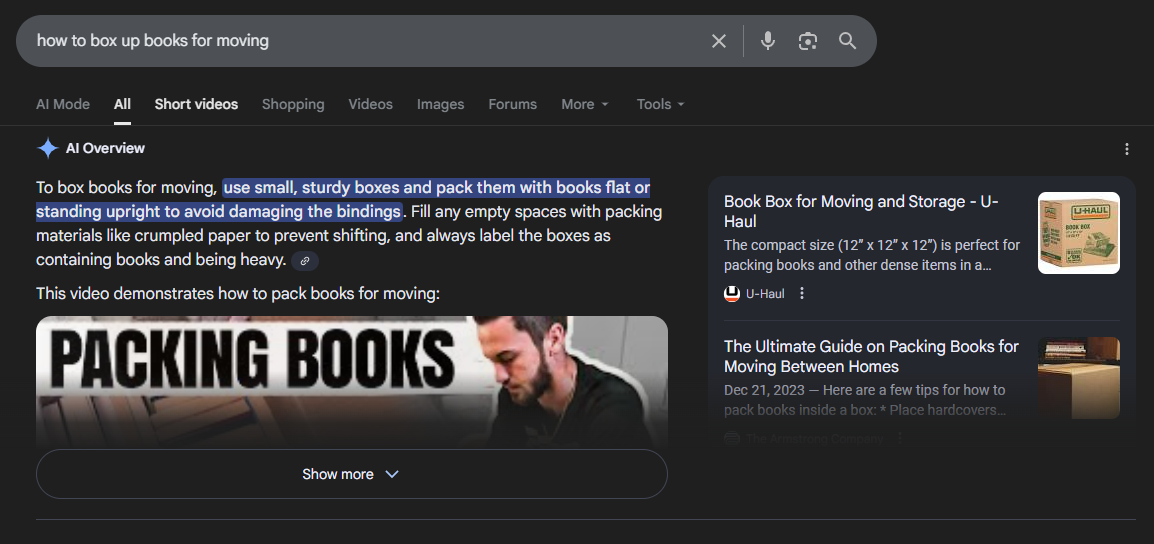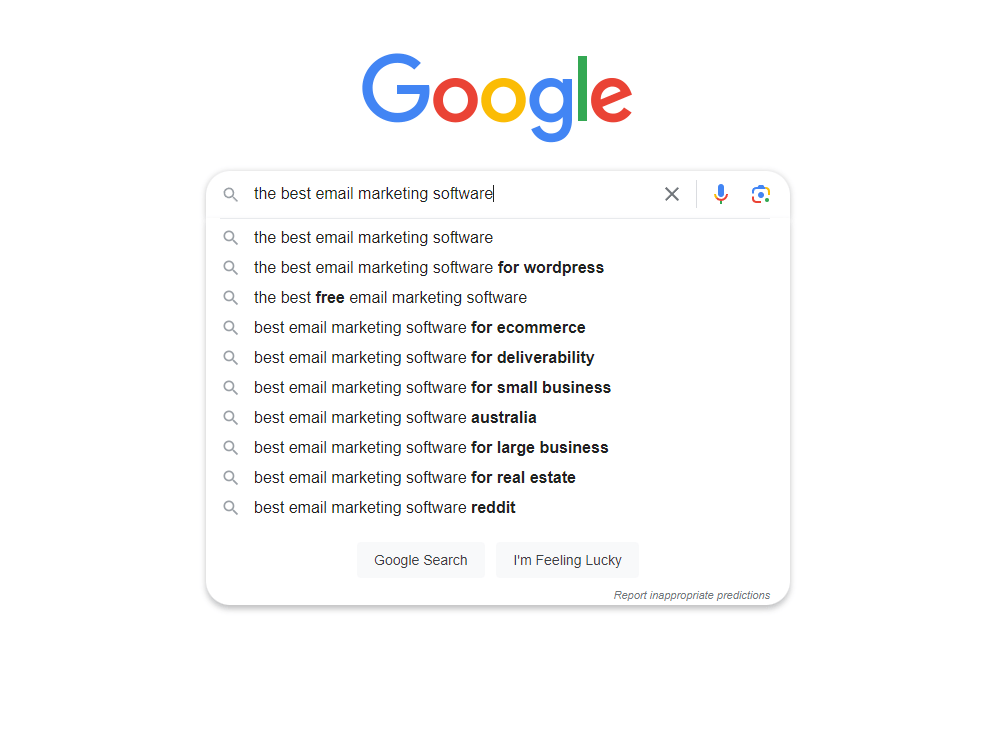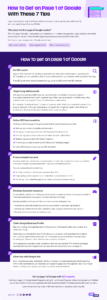- Why is ranking on Google’s first page critical? The first page of Google receives 95% of all search traffic, making it essential for brand visibility, organic traffic growth, and generating leads or sales — if you’re not on page one, you’re essentially invisible to most potential customers.
- How are AI Overviews changing first-page rankings? AI Overviews now appear at the top of many search results, reducing available ranking spots from 10 to 7-8 blue links and contributing to 58% of searches ending in no clicks, making it crucial to optimize content specifically for AI Overview inclusion.
- What makes content appear in AI Overviews? To increase chances of appearing in AI Overviews, provide direct answers to questions, leverage structured data (schema markup), focus on readability and scannability, and cover related topics comprehensively — AI prioritizes content that’s easy to understand and provides straightforward answers.
- Why are long-tail keywords more valuable for conversions? Long-tail keywords like ‘Nike’s best basketball sneakers’ attract fewer searches than general terms like ‘basketball shoes,’ but they yield higher conversion rates because searchers using specific queries are typically ready to take action rather than just browsing.
- How do backlinks help you rank on page one? Google uses backlinks as trust signals similar to academic citations — receiving links from reputable sites in your industry indicates authority and trustworthiness, which is one of Google’s most significant ranking factors for first-page placement.
In the words of Ricky Bobby, “If you ain’t first, you’re last.”
With users rarely visiting the second page of search results, it’s critical to rank on the first page of Google. That’s why we’ve compiled our tips for how to get your website on the first page of Google.

Why does the first page of Google matter?
The first page of Google — and getting your website on it — matters because few users visit beyond the first page of search results. In fact, the first page of search results receives 95% of the traffic.
So, if you can get on page one of Google, you can get:
- More brand visibility
- More organic traffic
- More leads and/or sales
How the first page of Google is changing with AI Overviews
I can’t talk about getting on the first page of Google without mentioning AI Overviews. You’ve likely noticed that, in a lot of the searches you conduct, AI Overviews appear front and center at the top of search results.

So, what does this mean for the first page of Google?
First, it means that there are less “spots” available to rank in. Previously, Google would have 10 blue links showing up in the search results — now, if AI Overviews appear (as well as other features), there might only be 7 or 8 spots in the SERPs for you to appear in.
Then, on top of that, you now need to optimize for AI Overviews because it’s the new “Position 0.” In fact, 58% of searches now end in no clicks, and AI Overviews are playing a large part in that. People are getting the answers they need from AI Overviews and moving on.
So, whether the keywords you target are showing AI Overviews or not, you need to optimize for page 1 on Google to ensure you’re visible to your audience.
How to get on page 1 of Google
Here are some best practices you’ll want to follow to get on the first page of Google:
1. Build a strategy for appearing in AI Overviews
AI Overviews are prime real estate for reaching your target audience in the searches that matter most to you. If you want to get on page 1 of Google, you need to develop a strategy for appearing in AI Overviews.
Like SEO, there’s no foolproof way to get your business appearing in AI Overviews. But, there are steps you can take to help optimize your pages to be more likely to get pulled into the AI Overviews.
Here are some ways you can optimize for AI Overviews:
- Provide direct answers to questions: Providing a succinct, straight-forward answer is a good way to get pulled into the AI Overviews. AI wants to give the most direct answer with no fluff — providing that direct answer makes you more likely to get pulled.
- Leverage structured data: Structured data (or schema markup) provides AI-powered engines will more context about your pages. Adding the appropriate schema to your page can help show that the information on your page is relevant and should be pulled for a response.
- Focus on readability: Creating content that is easily readable and scannable will increase your chances of appearing in AI Overviews. The easier it is for AI to understand what’s on your page, the better chance you have of appearing in search results.
- Cover related topics for content: When you look at AI Overviews, you’ll see that it’s not just citing the same types of pages that are targeting the original query. AI Overviews also pulls sources related to the original query. Making sure you have content that addresses all angles of a top can help you get pulled in the AI Overviews.
2. Target long-tail keywords

Long-tail keywords are a phenomenon for search engine optimization (SEO).
Although they get less traffic, they often yield higher conversion rates for businesses. Searchers looking for a general topic often receive an answer and click away, while someone with a very specific search is often ready to take action.
For example, “basketball shoes” is a general keyword, while “Nike’s best basketball sneakers” is a long-tail keyword. Although more people may search for the general option, the individuals browsing for the long tail keyword probably want to buy the shoes.
Use long-tail keywords to reach (and convert) your audience.
3. Produce helpful content
With AI dominating the marketing world, anyone can produce “content.” But, producing it just to have content on your website to rank in search won’t cut it — you need to produce helpful content.
You can produce helpful content by:
- Sharing anecdotes, like how your business does XYZ
- Highlighting author experience or credentials to demonstrate E-E-A-T
- Providing multimedia, like graphics or videos, to improve understanding
When you provide unique value, your content stands out from other content in the search engine results pages (SERPs). You also stand out to users by demonstrating that you know this topic — and can help them.
4. Match user search intent
A big part of getting your business on page one of Google is making sure that your pages match the search intent for the keyword you’re targeting. You want to ensure that you are providing the information that people look for when they search that query.
When you’re trying to match user search intent, you want to make sure that you’re meeting the user’s needs without copying everything that’s in the search results.
With the rise of AI Overviews, uniqueness of content is a really important factor for appearing the in the Overviews, so you want to make sure that you’re hitting the basic information that people want to get. At the same time, you also want to ensure you’re adding more to the conversation and giving users information they need.
5. Develop shareable resources
Your backlink profile is one of Google’s most significant ranking factors.
Google uses backlinks, similar to citations in academic papers, to understand the reputation and trust of a website. If you receive backlinks from reputable sites in your sector, that indicates trust to Google.
Building backlinks isn’t easy, but there are some proven strategies, like:
- Outreaching sites with broken links where your content is a relevant replacement
- Developing interactive tools, like a calculator, quiz, or game, relevant to your industry
- Producing first-party data via studies or polls
6. Claim Your Google Business Profile

Note: If your business doesn’t have a physical location, skip this tactic!
Google Business Profile is one of the most powerful tools for local businesses to rank on Google. Begin by creating a Business Profile account. You’ll need to claim your location and verify your listing.
Optimizing your Google Business Profile allows you to appear in Google Maps for localized searches, like ‘gluten-free bakery near me’. It’s key that you provide all the necessary data, including your phone number, address, hours, photos, and more.
Besides Google Business Profile, your organization can also create localized content on your website. This content can target localized searches with longer buyer journeys, like ‘renovation company Las Vegas, NV’.
Don’t fail your website’s most important test
Get an SEO scorecard of your website for free in less than 30 seconds.
8. Do regular SEO audits
Regular SEO audits (think monthly or quarterly) can help surface SEO issues or opportunities. For example, you can use SEO audits to resolve 404 errors on your website, which can affect rankings.
Keeping tabs on any issues with your SEO can help ensure you maintain rankings and give your pages a boost if they aren’t ranking.
Free SEO audit tools include Screaming Frog, as well as SEO.com’s free SEO checker.
Get on page 1 of Google with SEO experts
Getting on page 1 of Google doesn’t happen overnight — and doesn’t happen without some practice. Whether you’re new to SEO or too busy to optimize, the SEO experts at WebFX (the team behind SEO.com) can help.
Learn more about our custom SEO services now or request a custom quote!

$3bn+
revenue driven for clients



Add WebFX to your content marketing toolbox today
Get SEO ProposalTable of Contents
- Why Does the First Page of Google Matter?
- How the First Page of Google is Changing with AI Overviews
- How to Get on Page 1 of Google
- 1. Build a Strategy for Appearing in AI Overviews
- 2. Target Long-tail Keywords
- 3. Produce Helpful Content
- 4. Match User Search Intent
- 5. Develop Shareable Resources
- 6. Claim Your Google Business Profile
- 8. Do Regular SEO Audits
- Get on Page 1 of Google with SEO Experts
$3bn+
revenue driven for clients



Add WebFX to your content marketing toolbox today
Get SEO ProposalWhat to read next
- Nov 06, 2025
- 11 min. read
- Nov 05, 2025
- 9 min. read
- Nov 04, 2025
- 7 min. read




